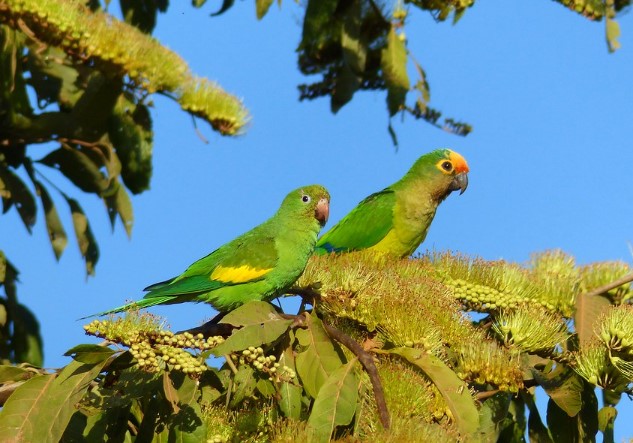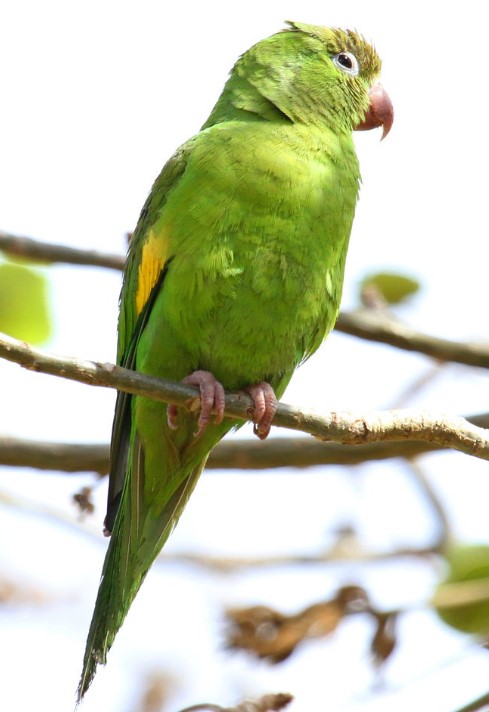Size: Yellow-chevroned parakeets are about 20-22 cm in length and weigh about 2.5 ounces (72 grams).
Identification: The color of this parakeet is mostly light green. When the bird is in flight, its folded wings have a trailing yellow edge. The legs and feet of these animals are pink-grey, with hook-shaped beaks that are orange-brown. Their eyes are dark brown and have creamy-white eye rings.
Diet: Feral populations of the bird have adapted to take in blossoms and nectar in their native habitat. They eat mostly seeds and fruit in their native habitats. Birds adapt to dry periods by eating more seeds, particularly those from (Erythrina dominguezii) during dry periods. Geophagia is also observed among these birds, which is the deliberate ingestion of soil, most commonly near clay licks. In addition to domestic birds, feral birds visit bird feeders as well. Forest clearings around settlements and disturbed forests are the most important habitats for wild birds. Tropical forests with deep roots are rarely used by them.

Talk: Yellow-chevroned parakeets can imitate human whistles and speech, as can many other psittacids. Some words and sounds can be mimicked by it. Medium-noisy is the best way to describe them.
Cage bird: The feathered lords are common cage birds, like (B. versicolorus), and possibly nonspecific.
Call & Sound: Yellow-chevroned parakeet calls with loud shrill chiri…chiri…ri or te-clee-tee, more high-pitched than (B. versicolorus). In flight, they make a lot of noise and are persistent. When perched in flocks, they are quieter.
Distribution: Located mainly below 1000 meters in the interior of eastern Brazil, Bolivia, and northern Argentina, this parakeet is common; introduced to California, Miami, Florida, Los Angeles, San Francisco, and Florida, United States, and possibly also to the Dominican Republic, where identification is not confirmed. South America’s native population is doing well.

Sub-Species: There are two slightly differentiated subspecies.
-
B. c. chiriri feathered lores green; secondary-coverts yellow; primaries green tinged blue. Range interior of eastern and southern Brazil, from Ceará, Maranhão and southern Pará south to Rio de Janeiro, western São Paulo and Mato Grosso, to eastern Bolivia, south to Santa Cruz, and through Paraguay to northern Argentina, in Formosa, Chaco, Misiones, and northern Corrientes.
-
B. c. behni is a little darker, less yellowish-green, and larger. Its ranges from central Bolivia to northwestern Argentina, in Salta.
Similar Species: The Plain Parakeet (B. chiric) has no yellow wings. Other Brotogeris species lack yellow in wings; they colored chin-spot or fore-crown.
Localities: Serra da Canastra National Park, Minas Gerais, and Caiman Lodge Wildlife Refuge, Mato Grosso do Sul, Brazil.
Nesting: Nests are usually found in holes in trees. Dead palm fronds are also used as nesting tunnels. Four to five eggs are laid by the female. All birds form rather large communal roosts after raising their young.
Eggs: There are 4-5 eggs laid in cavities in dead trees and palm fronds. As soon as they raise their young, these parakeets form large communal roosts until they are ready to breed again. Read More – The Sapphire-rumped Parrotlet







